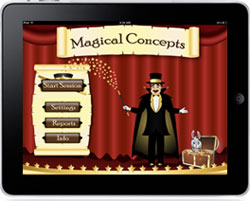The first thing one may want to do when opening the Fruit Find app is hit the music note icon, located on the upper right hand side of the screen, to off. If one doesn’t do this, the at first pleasant music begins to feel like a worm in one’s ear.
The name Fruit Find is a misnomer because it actually works on vegetable as well as fruit vocab, making it a more expansive than the name would suggest.
I like this app for a few reasons. First, the vocab presented is broad, allowing for the introduction of fruit and vegetable names that can truly expand a student’s vocabulary. Did you know that “brinjal” is another name for “eggplant?” It was a new vocabulary word for me and one not available in my dictionary app. I searched online and learned the following: In Indian, South African, Malaysian and Singaporean English, the fruit is known as a “vengan”, “baingan” or brinjal, with the latter being derived directly from the Portuguese beringela. Aubergine and brinjal, with their distinctive br-jn or brn-jl aspects, derive from Persian and Sanskrit. I like an app that is a learning experience.
There are more reasons to like this app. I like it’s task presentation, auto-advance to higher level, and scorecard option.
Upon opening this app, the first screen up is a pleasant wood scene with flowers growing along a path. Along side the path is a wooden stake with 3 plank signs. The first plank is Play All Day with a happy cucumber, the second is Tik Tok with a smiling orange and the third is Score Card with friendly tomatillo.
The pictures on this app are small photographs. They are presented in a grid format. The Play All Day option has 20 spaces on the grid. A different fruit or vegetable appears on the grid randomly placed. Above the grid is a small wood plank with 2 parallel lines on it. Tap on this plank and the game halts and new options slide down, again on wood planks. One can save the score up to the stop point, resume the game, or return to the main menu. At the top of the options selections is the game score up to the stopping point. Next to the stop button is a plank with a sound icon next to the written word for the picture. The name of the target word is repeated when this sound icon is tapped. The last plank at the top of the screen has a clock icon and the amount of time that has elapsed during play. Below this is a star icon and the number of stars earned. To the right of the grid are 10 stars. Each time the correct fruit or vegetable is tapped a brown star turns yellow. Each star earned is worth 10 points.
One starts Play All Day with 4 pictures appearing on the grid. A pleasant voice names a fruit or vegetable and the user needs to tap the picture named. If a picture is not tapped within 3 seconds, the correct picture starts to move up and down accompanied by a bouncing sound. Tap on this picture and one earns a star. Tap on the incorrect button and a sound of a plucked bass string is heard. The choices quickly advance in number to 5 pictures then 6 and so on, until one has 20 pictures from which to choose.
The Tik Tok game seems to combine testing with learning. When one taps the Tik Tok plank, a screen appears with 3 options: Easy, Medium and Hard. Tap on the Easy option and a grid with 12 squares appear and 3 pictures randomly placed on the grid. The auto-advance feature adds a fourth picture after five stars are earned. The Medium and Hard options present a 20 square grid. Each starts out presenting 4 pictures on the grid. The auto-advance feature adds a picture after 5 and then 10 stars are earned. The hard version advances a bit faster than the medium version. As in the Play All Day game, the picture named moves up and down if a selection is not made within a few seconds. Now here’s a feature I haven’t quite gotten a handle on. It seems to be a timing feature. If one reaches a certain level and doesn’t select a picture within a specific amount of time, in seconds, a clang is heard and the screen closes to reveal a screen with four signs. The first sign says Game Over and a score. Below that are, in descending order: Save Score, Play Again, and Main Menu.
As I mentioned earlier, there is a score card allowing for score keeping on the Play All Day option, and the 3 levels of Tik Tok. The user simply types in his/her name and the score attained appears in the appropriate box for the task just completed.
This app’s pictures are, for the most part, easily identifiable. Celery was a bit harder to identify because the picture has the stalks sitting in dirt (not sure about that either). There are a few pictures that are a bit distorted. Blueberries, for instance, are slightly elongated rather than perfectly round.
On the main screen one has the option to remove adds by tapping on the Remove Ads plank attached to a tree. The adds are not intrusive, but for only $.99 cents one can use the app without the ad nuisance. At $.99 this app is a bargain.
Suggested uses in addition to vocab: object parts, attributes, categories.
Upcoming blog: My very first lesson learned on my very first speech therapy app download.

